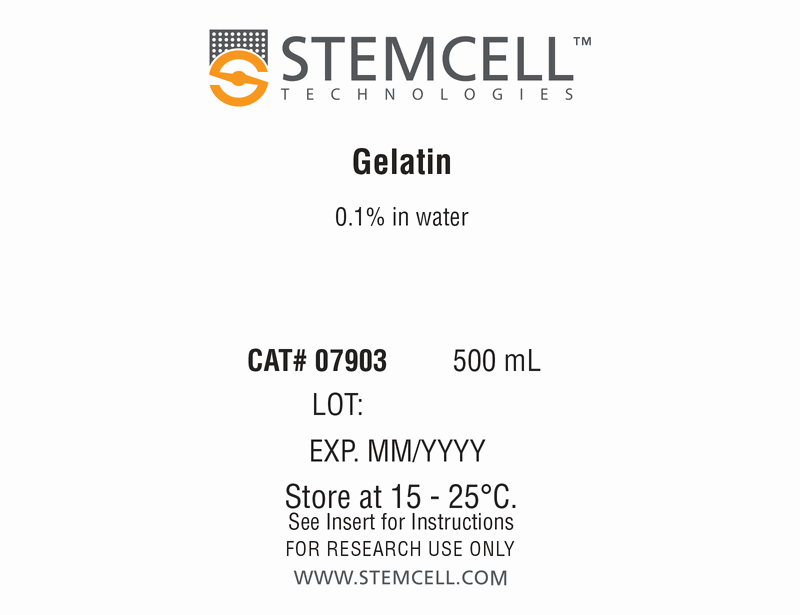0.1% Gelatin in Water
Coating for cultureware
概要
This product is recommended for the coating of culture dishes or flasks to grow mouse embryonic stem cells (mESCs), mouse induced pluripotent stem cells (miPSCs) or primary embryonic fibroblasts (PEFs).
Cell Type
Pluripotent Stem Cells
Species
Mouse, Rat, Non-Human Primate, Other
技术资料
| Document Type | 产品名称 | Catalog # | Lot # | 语言 |
|---|---|---|---|---|
| Product Information Sheet | 0.1% Gelatin in Water | 07903 | All | English |
| Safety Data Sheet | 0.1% Gelatin in Water | 07903 | All | English |
数据及文献
Publications (2)
Stem cells and development 2014 JUL
Functional comparison of human-induced pluripotent stem cell-derived mesenchymal cells and bone marrow-derived mesenchymal stromal cells from the same donor.
Abstract
Abstract
Mesenchymal stem cells (MSCs) have a high potential for therapeutic efficacy in treating diverse musculoskeletal injuries and cardiovascular diseases, and for ameliorating the severity of graft-versus-host and autoimmune diseases. While most of these clinical applications require substantial cell quantities, the number of MSCs that can be obtained initially from a single donor is limited. Reports on the derivation of MSC-like cells from pluripotent stem cells (PSCs) are, thus, of interest, as the infinite proliferative capacity of PSCs opens the possibility to generate large amounts of uniform batches of MSCs. However, characterization of such MSC-like cells is currently inadequate, especially with regard to the question of whether these cells are equivalent or identical to MSCs. In this study, we have derived MSC-like cells [induced PSC-derived MSC-like progenitor cells (iMPCs)] using four different methodologies from a newly established induced PSC line reprogrammed from human bone marrow stromal cells (BMSCs), and compared the iMPCs directly with the originating parental BMSCs. The iMPCs exhibited typical MSC/fibroblastic morphology and MSC-typical surface marker profile, and they were capable of differentiation in vitro along the osteogenic, chondrogenic, and adipogenic lineages. However, compared with the parental BMSCs, iMPCs displayed a unique expression pattern of mesenchymal and pluripotency genes and were less responsive to traditional BMSC differentiation protocols. We, therefore, conclude that iMPCs generated from PSCs via spontaneous differentiation represent a distinct population of cells which exhibit MSC-like characteristics.
Current Protocols in Molecular Biology 2014
CRISPR/Cas9-Directed Genome Editing of Cultured Cells.
Abstract
Abstract
Human genome engineering has been transformed by the introduction of the CRISPR (clustered regularly interspaced short palindromic repeats)/Cas (CRISPR-associated) system found in most bacteria and archaea. Type II CRISPR/Cas systems have been engineered to induce RNA-guided genome editing in human cells, where small RNAs function together with Cas9 nucleases for sequence-specific cleavage of target sequences. Here we describe the protocol for Cas9-mediated human genome engineering, including construct building and transfection methods necessary for delivering Cas9 and guide RNA (gRNA) into human-induced pluripotent stem cells (hiPSCs) and HEK293 cells. Following genome editing, we also describe methods to assess genome editing efficiency using next-generation sequencing and isolate monoclonal hiPSCs with the desired modifications for downstream applications.


